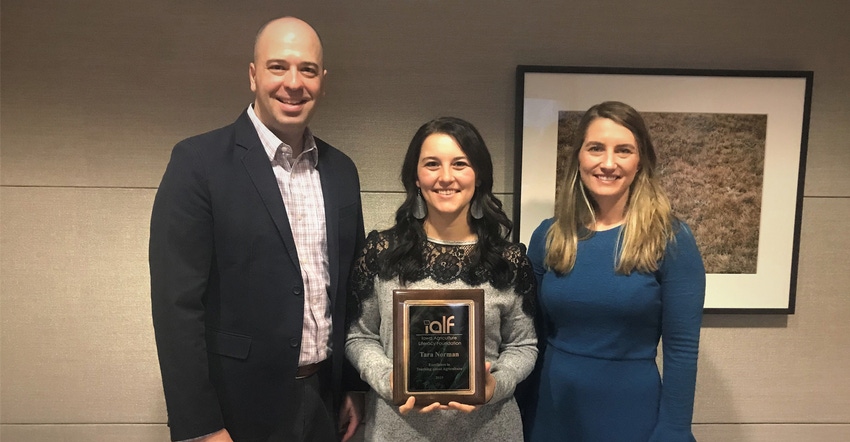December 18, 2019

Tara Norman, a third-grade teacher from Osceola, is the recipient of the Iowa Excellence in Teaching about Agriculture Award presented by the Iowa Agriculture Literacy Foundation. Norman competed against other elementary, middle and high school teachers to earn the honor. She was recognized Dec. 12 at the IALF board of directors meeting in West Des Moines.
Norman begins each school year asking students to unpack their school supplies and creates a map of where each product came from. The school supplies spark lessons on how each product is made. Students are often amazed to learn that there are ground cattle hooves in things like glue and soybean polymers in things like the inks in their pens. The cattle byproducts and soy byproducts all were originally produced on a farm.
“Agriculture is everything in our world,” Norman says. “I believe that like reading and math, agriculture is just as important to teach to our students.”
Teaching ag with other subjects
Norman also integrates ag into her social studies unit aligning with state educational standards, comparing past agricultural practices like hand planting corn seeds with modern practices like 48-row, technology-equipped planters. The students compare how agriculture has changed over time in farm size, tractor evolution, hand tools and even robots.
She also integrates ag into math lessons. Students learn about graphing and used data based on harvest rates, cattle weights and animal breeds. Students turn the data into various line plots, picture graphs and bar graphs.
Norman will receive a $500 stipend to support her continued efforts of integrating ag into her classroom curriculum. She hopes to expand her teaching efforts with a school garden or chicken coop on school grounds. She will also attend the National Agriculture in the Classroom conference in Salt Lake City in June.
Norman is in her third year of teaching at Clarke Community Elementary School where she has also organized an elementary agriculture club that students in grades three to six can participate. She earned her degree from Northwest Missouri State University where she graduated with honors. In her current role, she facilitates a life-cycles unit for her students by completing an egg hatching experiment with her class. The students monitor the daily progress of the chick in their journal.
They learn how to handle eggs and learn about different breeds of chickens. Students create daily videos that are shared with all elementary teachers and students, so the entire school can monitor the process of the 21-day experiment. Once the chicks hatch, the students make daily observations about behavior and changes as the chicks grow. Students take all responsibility for daily care, including watering, feeding and cleaning of the cage.
Help students learn about farming
Brandi Boyd is the high school ag education instructor at Clarke Community Senior High School. She says, “Tara is a wonderful advocate for agriculture. I am continually inspired by her positive attitude and determination.”
Boyd adds, “Not only does she integrate agriculture into her lessons, she also has gone above the call of duty to create opportunities to enhance student’s learning by creating an ag club at the elementary.”
Runner-up for the award is family and consumer science teacher, Megan Thorson, of Northwood-Kensett Community School District. Thorson also will attend the National Ag in the Classroom conference, having her registration fees covered in honor of her exceptional work. Thorson has integrated agriculture into her classroom through beef, egg and pork nutrition lessons. She also has a hydroponic tower garden in her classroom to grow fresh vegetables year-round.
“All the food that we cook and learn about has to do with agriculture because all food is grown,” Thorson says. “When I first started teaching in the classroom last winter, I was surprised how much the students did not know about the food we eat. I felt like it was a good fit to use my ag background so I could share how foods are grown or raised, and how we are able to use this food every day in our class.”
Source: IALF, which is solely responsible for the information provided and is wholly owned by the source. Informa Business Media and all its subsidiaries are not responsible for any of the content contained in this information asset.
You May Also Like




